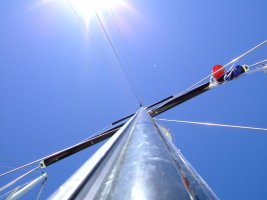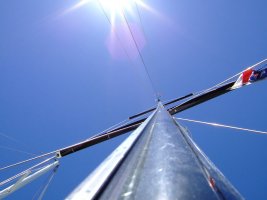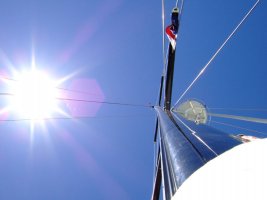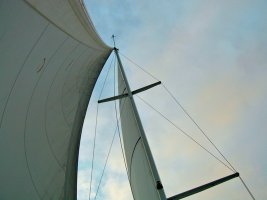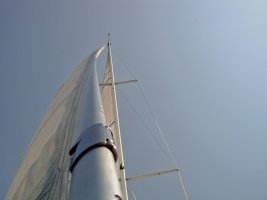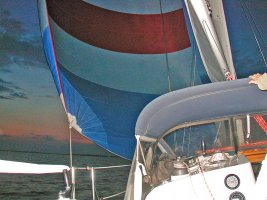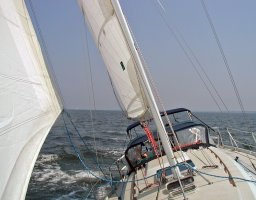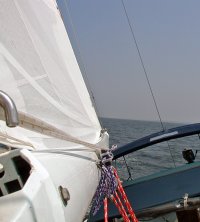NICE shots!!
Ted-The boom looks OK I think-SWEET looking main. Headstay sag seems appropriate-not horrible anyway, considering no BS adjuster yet.
The lead on your kite needs to go WAY back-at least for reaching (might be OK when running). Note the big hook in the leech? That is the lead too far fwd. This has the SLOW effect of closing off the exit of the sail, and also creating a lot of heeling force, which could cause control problems (round ups) when pressed in big breeze-move it aft!!! Open the leech!
FRANK-Good question-I should have explained more. Ben basically beat me to it, but to elaborate: Luff curve in a mainsail is one of the 2 factors that create "depth"(chord depth actually)-and hence power. The other is actual shaping in the seams. Luff curve is material on the luff forward of a straight line from head to tack. When the mast is straight, all of this material is loose and creating/adding depth to the sail. As you bend the mast, this material is taken up, and the depth is eliminated/removed. Typically we design mainsails to have a luff curve of about 80% of available mast bend-meaning that by the time you have bent the mast to 80% of available bend, most (if not all) of the luff curve/shape/draft/power has been taken up or removed. This means you can have a very "powered up" main with the mast straight (as you would want in lighter air), and a very flat main (depowered) in heavy air with the mast bent. The "curve fitting the bend" comment was to ask if the sail could go from full to flat with the available range of adjustment. If you have a mast that can bend 8 inches, but only have 3" of luff curve, the sail will become very flat as soon as you begin to bend the mast-too soon in fact.
Conversely, if you have 10" of luff curve (deep sail), but can only bend the rig 5 " you will never be able to get the sail flat enough. When you have a mast with very little bending ability (like a 35-2), the solution is to put more of the shaping into the seams instead of luff curve. Use maybe 3" of luff curve since there is only about 4" available on this mast, but put more shaping in the seams to get the depth. The seam shaping is affected by outhaul, flattening reef, cunningham, and sheet, and to a small extend, mast bend. Boats with bendy rigs have mainsails built with more luff curve than seam shaping..again, to have the best adjustment range.
I hope that helps make this a bit more clear-great questions!!!
Cheers,
S



